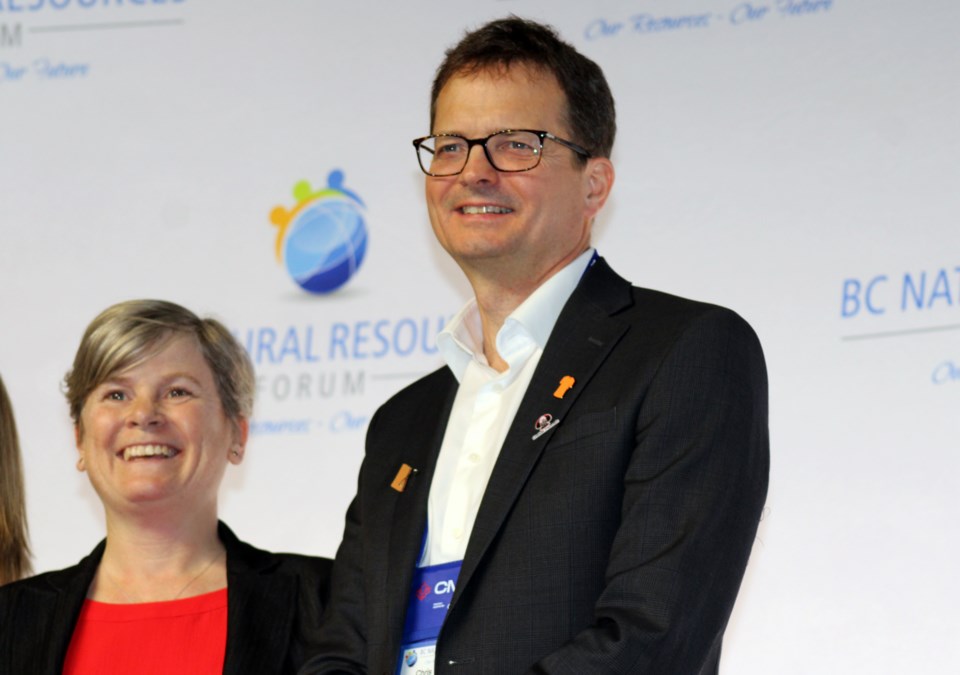As president and CEO of BC Hydro, Chis O’Riley knows he’s going to be a big spender over the next 10 years.
Premier David Eby has promised him a $36 billion bankroll to pay for an unprecedented level of spending on infrastructure projects the province intends to undertake in the coming decade.
“We have a pretty comprehensive plan and the money will be spent on the transmission and distribution system and our current generation facilities and we’ll be guided by the decisions and actions of our customers and where and when they want to connect to our system,” said O’Riley, in Prince George this week for the BC Natural Resources Forum.
“Our goal is to make sure we have reliable power delivered to where it’s needed in the province.”
One place he intends to start investing is the network of a million power poles that hold up the wires that electrify British Columbia. BC Hydro is tackling a project to replace 100,000 of those poles.
“(The cost) depends where you are,” said O’Riley. “There’s a whole program around that and the more you do it once the cheaper it goes.”
New substations in the Lower Mainland, upgrades to existing dams and generating facilities, and a new transmission line on the north are among the projects BC Hydro is currently undertaking.
The $3 billion transmission line twinning project between Prince George and Terrace has already begun and O’Riley says construction has started on the three new capacitor stations that will add 500 megawatts to the line to the Skeena and the North Coast, which will boost capacity 60 per cent to meet the growing demand for power.
“There’s a whole range of projects like mines, that we’re used to here, there’s port facilities, there are some LNG terminals, there’s some clean-tech hydrogen production,” said O’Riley. “We’re in talks with those really large customers and looking how we can make that work.”
O’Riley said sa国际传媒 has gone through a 15-year period in which demand for electricity was constant, and reductions in the forest sector and improvements in lighting efficiency allowed the province to maintain its power surplus. But Eby said that supply is expected to surge to 3,000 megawatts with ramped-up demand for more electric vehicles and buildings and a switch to electrified construction equipment.
“There’s broad recognition we need more electricity and with that comes greater acceptance of the need for Site C,” said O’Riley.
Construction of the earth-fill Site C dam was completed in July and the four-month filling process that was at first scheduled for last fall was put off until the fall of 2024 due to unfinished work on the approach channel, spilling gates and intake gates at the powerhouse.
The dam will have a capacity of 1,100 megawatts and is on track to produce power late this year with all six generating units expected to be producing in 2025.
Hydro rates in sa国际传媒 are among the cheapest in sa国际传媒. In November the rate was 11.4 cents per kilowatt hour. Only Quebec (7.8 cents)and Manitoba (10.2 cents) had cheaper power. O’Riley said BC Hydro has held its rate below inflation for seven years.
Increased power demands, expected to spike 15 per cent in six years, are not unique to sa国际传媒 but the province has built-in flexibility to deal with peak demand and is able to share electricity with other jurisdictions, as was demonstrated over the past week when the province sent some of its surplus to Alberta and Washington state.
With more electric vehicles and increased power usage to run net-zero home heating appliances such as heat pumps, communities will require infrastructure upgrades with thicker distribution cables and more powerful transformers needed to bring power to houses and businesses gearing up for greener systems.
“We are working to enhance our distribution system, the way we get power around cities to make sure we can accommodate greater loads and we’re seeing increased density on building lots and more units on one lot, moving away from single-family homes,” said O’Riley.
“So all of those changes are reflected in our planning and it’s our job to make sure we meet those requirements.”

